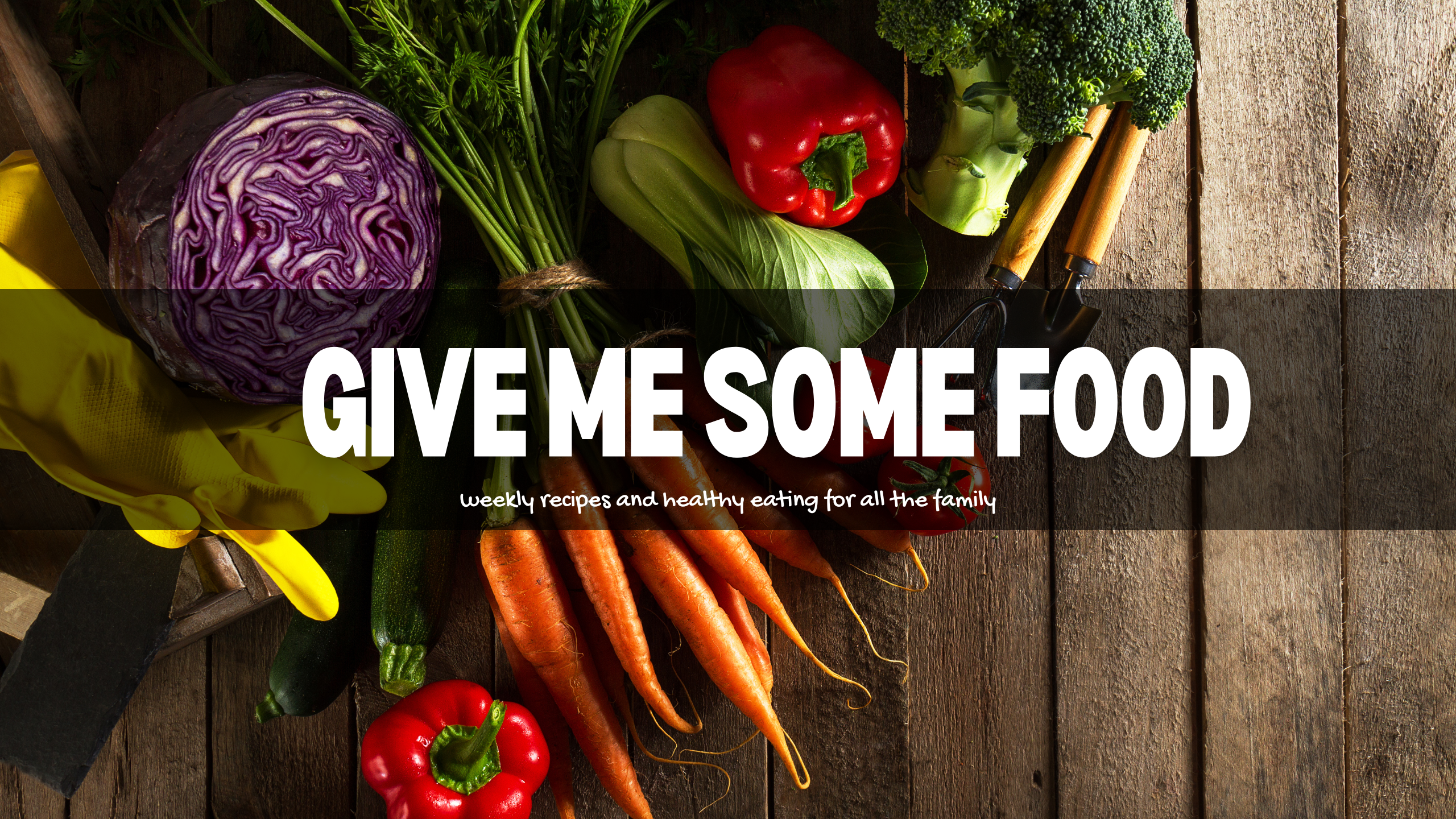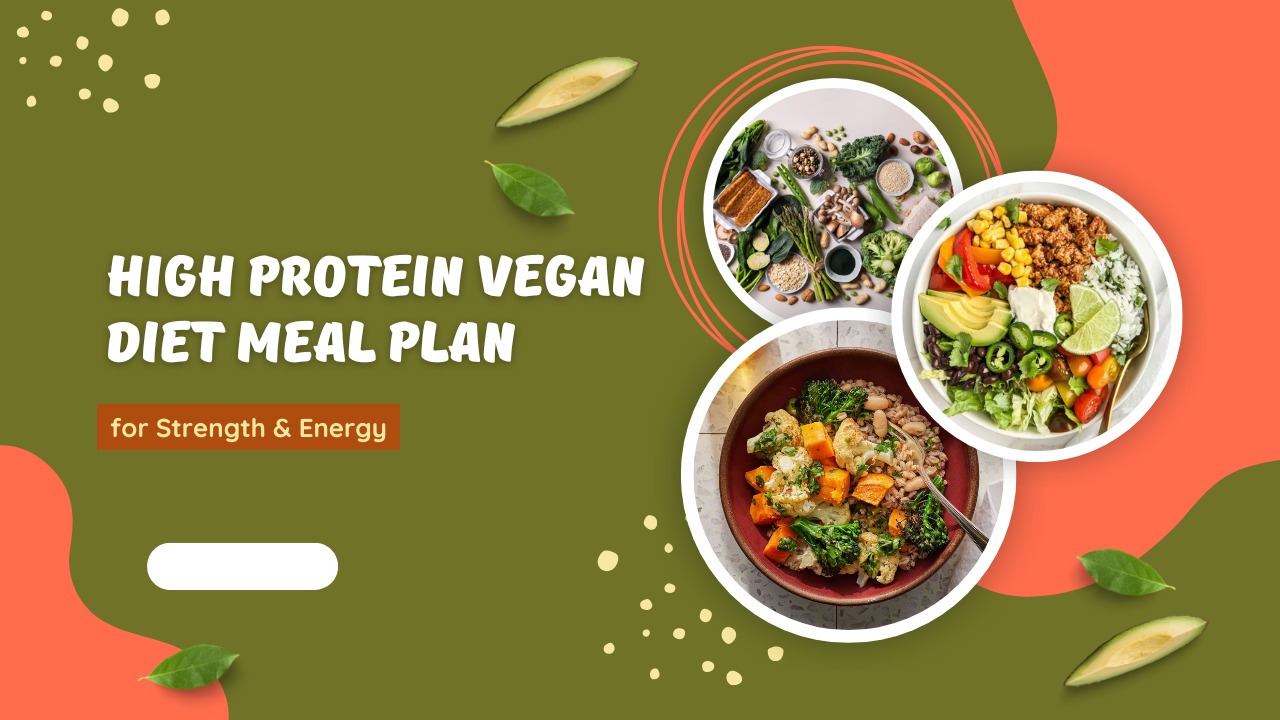High protein vegan diet meal plan options have become increasingly popular as the vegan lifestyle moves into the mainstream. Whether for health, the planet, or animal welfare, more people are embracing plant-based living — and asking if it’s possible to meet protein needs without meat or dairy.
The answer is absolutely yes. With thoughtful planning, a high protein vegan diet meal plan can supply all essential amino acids for muscle maintenance, fat loss, and overall vitality. Foods like lentils, tofu, tempeh, seitan, edamame, and quinoa are excellent plant-based protein sources.
Following a high protein vegan diet meal plan not only supports fitness goals but also enhances energy, digestion, and long-term health. From hearty grain bowls to protein-packed smoothies, plant-powered meals can be both satisfying and nutritionally complete — without sacrificing your values or taste.
In this article, we’ll explore what a high-protein vegan diet is, why it matters, how to build it properly, and when to eat your meals for optimal results. Plus, we’ll give you 8 powerful tips, complete with benefits and food suggestions to supercharge your plant-based lifestyle.
What Is a High-Protein Vegan Diet ?
A high protein vegan diet focuses on increasing protein intake through entirely plant-based sources. While traditional high-protein diets often rely on meat, eggs, and dairy, a vegan version eliminates all animal products and instead includes legumes, soy-based foods, grains, nuts, seeds, and certain vegetables to meet protein needs.
Protein is essential for muscle repair, hormone production, immune function, and overall body maintenance. For vegans, achieving adequate protein intake is very possible with proper food choices and planning. Foods like lentils, tofu, tempeh, quinoa, seitan, chia seeds, and chickpeas are staples in a high protein vegan diet meal plan.
To ensure a complete amino acid profile, it’s important to eat a variety of plant-based proteins throughout the day. Combining grains with legumes or nuts with seeds helps create a well-rounded diet. This strategy supports muscle building, fat loss, and improved energy levels.
A well-structured high protein vegan diet meal plan can benefit athletes, fitness enthusiasts, and anyone seeking a healthy lifestyle. With the right ingredients, plant-based eating can be both protein-rich and satisfying.
A high-protein vegan diet is a plant-based eating plan that prioritizes protein-rich foods while excluding all animal products — including meat, dairy, and eggs. It emphasizes:
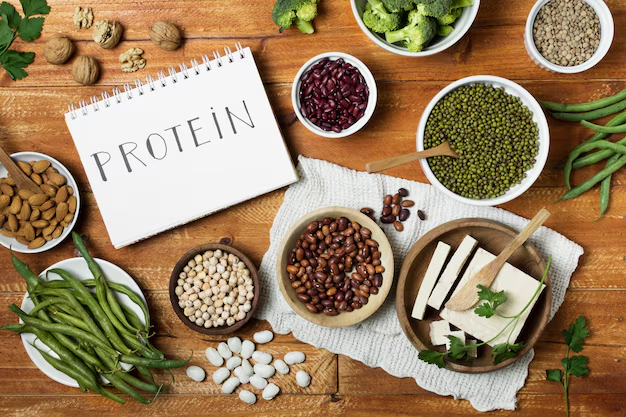
Legumes (beans, lentils, peas)
Soy products (tofu, tempeh, edamame)
Whole grains (quinoa, oats, brown rice)
Nuts and seeds
Protein-rich vegetables
Vegan protein powders
How Much Protein Do You Need ?
Protein needs vary based on age, activity level, and health goals. On average, adults require about 0.8 grams of protein per kilogram of body weight per day. However, if you’re active, looking to build muscle, or aiming for fat loss, your needs may rise to 1.2–2.0 grams per kilogram.
For those following a high protein vegan diet meal plan, it’s important to track your intake and choose diverse plant-based sources to meet these goals. Foods like lentils, tofu, tempeh, edamame, quinoa, and hemp seeds can help you easily hit your daily protein target while keeping your meals balanced and satisfying.
A well-planned high protein vegan diet meal plan can meet or even exceed protein requirements without relying on animal products. By eating a variety of whole foods and focusing on nutrient-dense options, you can fuel your body effectively and support overall wellness.
Average adults: 0.8 grams per kilogram of body weight
Active individuals or athletes: 1.2–2.0 g/kg
Bodybuilders or those looking to gain muscle: up to 2.2 g/kg
For example, a 70 kg (154 lbs) individual aiming to build muscle may need 100–154 grams of protein per day.
Why Focus on High-Protein in a Vegan Diet ?
Focusing on protein in a vegan diet is crucial because plant-based sources typically contain less protein per serving than animal-based foods. Without proper planning, vegans may fall short on this essential macronutrient, which is vital for muscle repair, hormone balance, and overall cellular function.
Including more protein-rich foods in your meals helps maintain lean muscle mass, especially as you age or increase physical activity. A well-balanced high protein vegan diet meal plan supports fitness goals like fat loss, strength building, and enhanced recovery after workouts.
Moreover, high-protein foods increase satiety, reducing unhealthy snacking and helping regulate blood sugar levels. A strategic high protein vegan diet meal plan not only improves nutritional intake but also promotes long-term energy, focus, and weight management. By making protein a priority, vegans can enjoy a diet that is both ethical and highly effective for overall health.
Protein is essential for:
Muscle building and repair
Satiety and weight management
Enzyme and hormone production
Immune function
Metabolism support
Many plant-based foods are rich in carbohydrates and fiber but relatively lower in protein. That’s why intentional planning is key to ensure you’re getting sufficient protein while enjoying the benefits of a vegan diet.
When Should You Eat Protein on a Vegan Diet ?
Distribute protein intake evenly throughout the day to maximize muscle protein synthesis and prevent muscle breakdown.
A common approach:
Breakfast: 20–30g protein
Lunch: 25–35g
Dinner: 25–35g
Snacks: 10–20g
Post-workout meals or shakes are particularly important for those involved in resistance training or endurance sports.
How to Build a High-Protein Vegan Meal Plan
Creating a high-protein vegan meal plan involves:
Calculating your daily protein needs
Selecting protein-rich plant foods
Using diverse sources to ensure complete amino acid profiles
Meal prepping to stay consistent
Supplementing wisely (e.g., B12, vitamin D, omega-3s)
Top Tips for a High-Protein Vegan Diet
Embrace Soy Power – Tofu, Tempeh, and Edamame

Soy-based foods are powerful protein sources in any high protein vegan diet meal plan. Tofu, tempeh, and edamame offer complete proteins, meaning they provide all nine essential amino acids your body needs. These versatile ingredients are not only rich in protein but also packed with important nutrients like calcium, iron, and fiber.
Tofu is incredibly adaptable—great in stir-fries, soups, or even smoothies. Tempeh, with its nutty flavor and firm texture, is perfect for grilling, sautéing, or crumbling into dishes as a meat alternative. Edamame, or young soybeans, make for a convenient snack or a protein boost in salads and grain bowls.
Incorporating tofu, tempeh, and edamame into your high protein vegan diet meal plan is an easy way to meet your daily protein needs without sacrificing taste or variety. These soy superstars help make plant-based eating both delicious and nutritionally complete.
Why it works: Soy is a complete protein—meaning it contains all nine essential amino acids. It’s also versatile and rich in iron and calcium.
Benefits:
Builds lean muscle
Supports bone health
Satisfies hunger
Top Ingredients:
Tofu (10g protein per 100g)
Tempeh (19g per 100g)
Edamame (11g per 100g)
Meal Ideas:
Tofu scramble for breakfast
Tempeh stir-fry for lunch
Edamame salad as a snack
Load Up on Legumes
Legumes are a cornerstone of any high protein vegan diet meal plan. Packed with plant-based protein, fiber, iron, and complex carbohydrates, legumes like lentils, chickpeas, black beans, kidney beans, and peas provide both nutrition and satiety. They’re also budget-friendly and widely available, making them a practical choice for everyday meals.
Lentils are quick to cook and ideal for soups, curries, and salads. Chickpeas can be roasted for snacks, blended into hummus, or tossed into grain bowls. Black beans and kidney beans add texture and protein to tacos, chili, and stir-fries. These legumes not only fuel your body but also support digestive health thanks to their high fiber content.
Including a variety of legumes in your high protein vegan diet meal plan helps ensure you get a diverse array of nutrients and amino acids. With so many delicious ways to prepare them, legumes make plant-based eating hearty, wholesome, and satisfying.
Why it works: Beans and lentils are staples in many cultures and pack a solid protein punch along with fiber and minerals.
Benefits:
Promotes gut health
Stabilizes blood sugar
Keeps you full longer
Top Ingredients:
Lentils (9g per 100g cooked)
Chickpeas (7g per 100g)
Black beans (8g per 100g)
Meal Ideas:
Chickpea curry
Lentil soup
Bean burritos
Include High-Protein Grains
High-protein grains are an essential part of a balanced high protein vegan diet meal plan. Unlike refined grains, these nutrient-dense options offer both protein and complex carbohydrates, helping to sustain energy levels while supporting muscle repair and overall health. Quinoa, farro, amaranth, teff, and buckwheat are among the top choices.
Quinoa is a standout because it’s a complete protein and cooks quickly, making it perfect for salads, bowls, and side dishes. Amaranth and teff are excellent in porridge or baked goods, while farro and buckwheat add heartiness to soups and stir-fries. These grains also provide essential nutrients like magnesium, iron, and B vitamins.
Including these grains into your high protein vegan diet meal plan adds variety, texture, and protein to your meals. Swapping out white rice or pasta for protein-rich grains is an easy way to upgrade your nutrition and keep your plant-based meals satisfying and complete.
Why it works: Some grains are surprisingly high in protein, especially when paired with legumes for a complete profile.
Benefits:
Energy-boosting carbs + protein
Great base for meal prep bowls
Top Ingredients:
Quinoa (8g per cup cooked)
Amaranth (9g per cup cooked)
Oats (5g per half-cup dry)
Meal Ideas:
Quinoa Buddha bowl
Overnight oats with almond butter
Amaranth porridge with fruit and seeds
Choose Protein-Rich Veggies
Vegetables aren’t just about fiber and vitamins—they can also be surprisingly good sources of protein. Including protein-rich veggies in your high protein vegan diet meal plan helps boost overall protein intake while adding essential nutrients and antioxidants. Vegetables like spinach, broccoli, Brussels sprouts, green peas, and kale are especially valuable.
Spinach and broccoli, for example, offer about 5 grams of protein per cooked cup and are rich in iron and calcium. Green peas pack around 8 grams of protein per cup and are great in soups, stir-fries, or mashed into spreads. These veggies are low in calories yet high in nutritional density, making them perfect for weight management and energy.
By adding a variety of protein-rich vegetables to your high protein vegan diet meal plan, you enhance your meals with color, texture, and essential nutrients. These powerhouse plants support muscle function, immune health, and overall vitality—completely plant-based.
Why it works: While not high in protein individually, leafy greens and cruciferous veggies contribute to your daily total.
Benefits:
High in fiber and antioxidants
Low-calorie but nutrient-dense
Top Ingredients:
Spinach (3g per 100g)
Broccoli (3g per 100g)
Brussels sprouts (3.5g per 100g)
Meal Ideas:
Broccoli and tempeh stir-fry
Kale and quinoa salad
Green smoothie with spinach and protein powder
Snack Smart with Nuts and Seeds
Snack Smart with Nuts and Seeds
Nuts and seeds are nutrient-dense snacks that fit perfectly into any high protein vegan diet meal plan. Not only are they rich in protein, but they also provide healthy fats, fiber, vitamins, and minerals like magnesium and zinc. Almonds, peanuts, sunflower seeds, pumpkin seeds, chia seeds, and hemp seeds are some of the best options.
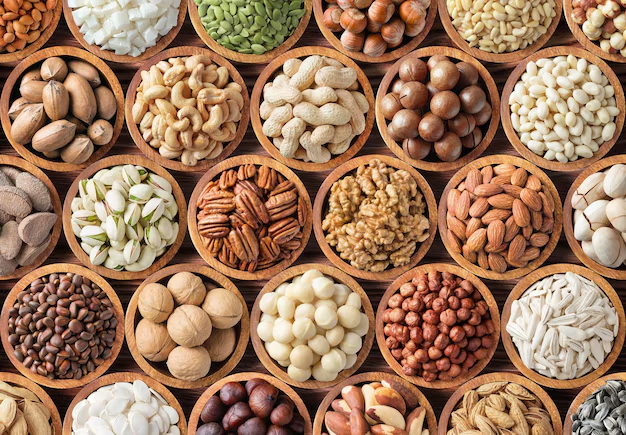
Chia and hemp seeds are especially protein-packed and can be easily added to smoothies, oatmeal, or plant-based yogurt. Pumpkin seeds (pepitas) make a crunchy topping for salads or soups, while nut butters like almond or peanut butter add both flavor and protein to snacks or toast. These snacks help curb hunger and keep energy levels stable throughout the day.
Incorporating a variety of nuts and seeds into your high protein vegan diet meal plan supports muscle health, brain function, and heart wellness. Just remember to enjoy them in moderation, as they are calorie-dense yet incredibly satisfying.
Why it works: Nuts and seeds provide protein, healthy fats, and micronutrients like magnesium and zinc.
Benefits:
Supports heart and brain health
Excellent for pre/post-workout snacks
Top Ingredients:
Almonds (6g per ounce)
Chia seeds (5g per 2 tbsp)
Hemp seeds (10g per 3 tbsp)
Meal Ideas:
Chia pudding
Nut butter toast
Trail mix with pumpkin seeds
Use Vegan Protein Powders Wisely
Vegan protein powders can be a convenient and effective way to boost your protein intake, especially when you’re following a high protein vegan diet meal plan. They’re particularly helpful for busy individuals, athletes, or anyone needing an extra protein boost without a full meal. Popular options include pea, rice, hemp, soy, and mixed plant protein blends.
These powders can be added to smoothies, oatmeal, plant-based yogurt, or even baked goods to enhance the protein content. A single scoop often contains 15–25 grams of protein, making it a fast and efficient option for post-workout recovery or meal supplementation. Look for products with minimal additives and complete amino acid profiles.
While whole foods should form the base of any high protein vegan diet meal plan, vegan protein powders are a useful tool for meeting daily requirements. Use them strategically to complement your meals and stay energized throughout the day.
Why it works: Vegan protein powders are concentrated sources from peas, brown rice, hemp, or soy—perfect for busy days.
Benefits:
Convenient protein boost
Great post-workout recovery
Top Ingredients:
Pea protein isolate
Soy protein
Hemp protein blends
Meal Ideas:
Protein smoothie with banana and spinach
Protein oats (“proats”) with almond butter
Vegan protein bars (homemade or store-bought)
Combine Foods for Complete Proteins
One key to a successful high protein vegan diet meal plan is combining plant foods to form complete proteins. While most plant-based sources lack one or more essential amino acids, pairing the right foods ensures your body gets all nine it needs for muscle repair, energy, and overall health.
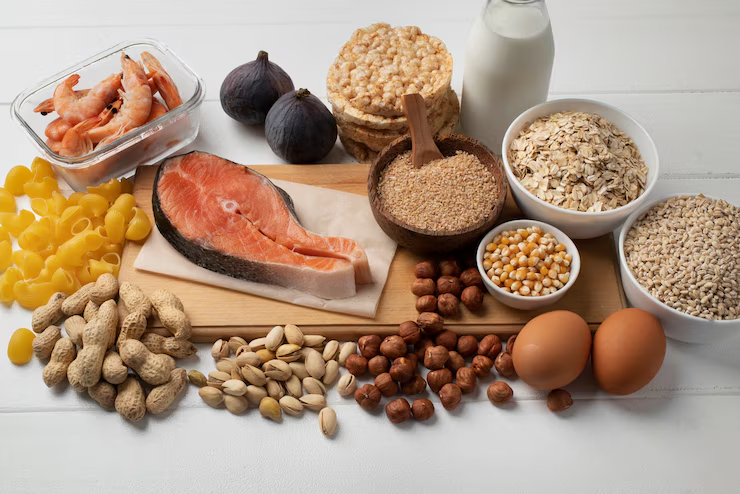
Classic combinations like rice and beans, hummus with whole wheat pita, or peanut butter on whole grain toast are simple yet powerful examples. These pairings complement each other’s amino acid profiles, creating complete proteins when eaten together or throughout the day. You don’t have to combine every meal, but balance across the day is essential.
Including these smart combinations in your high protein vegan diet meal plan ensures you’re not just getting enough protein—but the right kind. With a little variety and planning, you can enjoy delicious, plant-powered meals that support strong muscles, metabolism, and full-body wellness.
Why it works: Most plant proteins are incomplete. Combining foods ensures all essential amino acids are consumed.
Benefits:
Supports full-body repair and recovery
Maximizes absorption and nutrient use
Smart Combinations:
Rice + beans
Hummus + whole wheat pita
Peanut butter + whole grain toast
Plan and Prep Your Meals
Plan and Prep Your Meals
Meal planning is essential for staying consistent with a high protein vegan diet meal plan. Without a solid strategy, it’s easy to fall short on protein or reach for less nutritious options. By taking time each week to plan meals and snacks, you can ensure a balanced intake of protein-rich, plant-based foods.
Start by creating a weekly menu that includes a variety of legumes, tofu, tempeh, whole grains, nuts, seeds, and protein-rich veggies. Prepping items like cooked quinoa, roasted chickpeas, or marinated tofu in advance makes assembling meals quick and stress-free. You can also portion out snacks like trail mix or overnight oats for convenience.
Following a high protein vegan diet meal plan becomes much easier when your meals are ready to go. Consistent planning not only saves time but also helps you meet your nutrition goals, stay energized, and enjoy flavorful, satisfying plant-based dishes every day.
Why it works: Consistency is key to meeting protein goals. Meal planning removes guesswork and temptation.
Benefits:
Saves time
Prevents nutrient gaps
Helps with portion control
Meal Prep Tips:
Cook grains and beans in batches
Keep chopped veggies and sauces ready
Use glass containers for grab-and-go meals
Sample 1-Day High-Protein Vegan Meal Plan (100–120g Protein)
Here is your meal plan presented in table form with the keyword high protein vegan diet meal plan:
| Meal | Food | Protein |
|---|---|---|
| Breakfast | Tofu scramble with spinach + oats | 25g |
| Snack | Vegan protein shake + banana | 20g |
| Lunch | Quinoa + chickpea salad + tahini | 30g |
| Snack | Chia pudding + almonds | 15g |
| Dinner | Lentil curry + brown rice + broccoli | 25g |
This high protein vegan diet meal plan provides a balanced intake of plant-based protein throughout the day, supporting energy, muscle maintenance, and overall wellness.
Supplements to Consider on a Vegan Diet
Even with a perfect meal plan, some nutrients can be hard to get from plants alone:
Vitamin B12 – essential for nerve health
Vitamin D3 – supports immune system and bone strength
Omega-3s (ALA, EPA, DHA) – supports brain and heart health
Creatine (optional for athletes)
Conclusion
A high protein vegan diet meal plan is not only achievable—it can be incredibly satisfying, energizing, and aligned with your health or fitness goals. Whether you’re aiming to build muscle, lose fat, or boost overall wellness, plant-based proteins can fully support your journey when chosen and combined wisely.

Protein plays a vital role in muscle repair, metabolic function, and sustained energy. Whether you’re lifting weights, running marathons, or simply focusing on daily wellness, meeting your protein needs is essential. The key is to include a variety of plant-based sources like legumes, tofu, grains, nuts, and seeds.
By following the 8 tips in this guide, you’ll be well-equipped to create a powerful, nutrient-rich high protein vegan diet meal plan. Smart planning and diverse food choices will help you fuel your body, improve performance, and thrive on a plant-powered lifestyle—all without relying on animal products.
FAQs
Q1. Can I really get enough protein on a vegan diet ?
Yes! A high protein vegan diet meal plan can easily meet your daily protein needs by including foods like legumes, tofu, tempeh, quinoa, nuts, seeds, and plant-based protein powders.
Q2. What are the best protein sources for a vegan meal plan ?
Great plant-based protein sources include lentils, chickpeas, black beans, edamame, tofu, tempeh, quinoa, hemp seeds, chia seeds, and seitan. These are staples in any high protein vegan diet meal plan.
Q3. Do I need to combine foods to get complete protein ?
While not necessary at every meal, combining foods like grains and legumes across the day ensures a complete amino acid profile. This helps make your high protein vegan diet meal plan more effective.
Q4. How much protein should I aim for daily ?
Most active adults need 1.2–2.0 grams of protein per kilogram of body weight. Your high protein vegan diet meal plan should reflect your individual fitness and health goals.
Q5. Can a high-protein vegan diet support muscle building ?
Absolutely. With sufficient calories, strength training, and a well-planned high protein vegan diet meal plan, building and maintaining muscle is entirely possible on a vegan diet.
